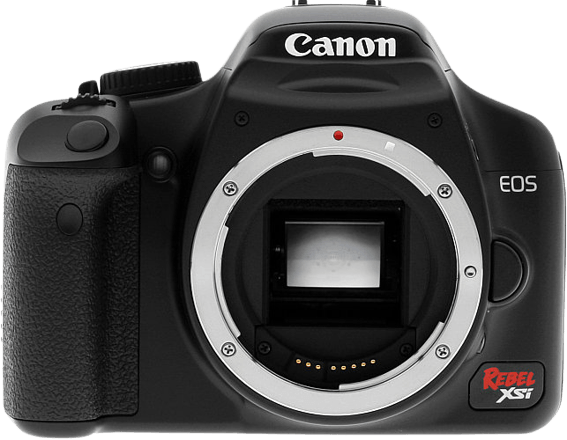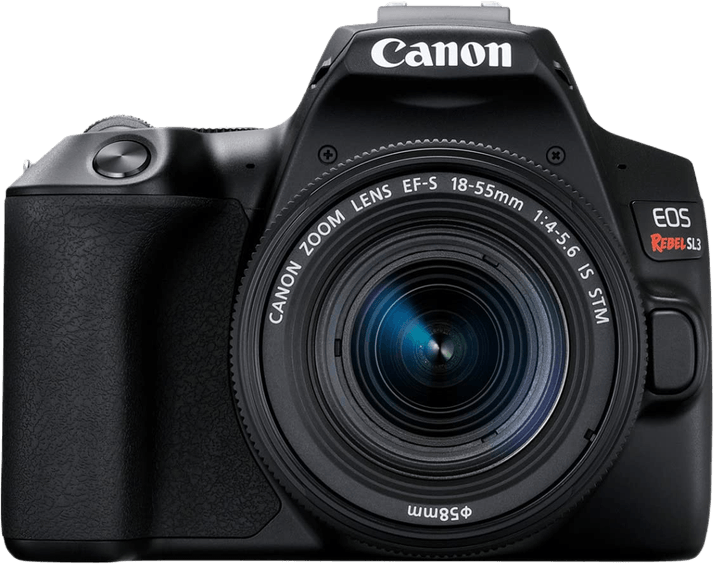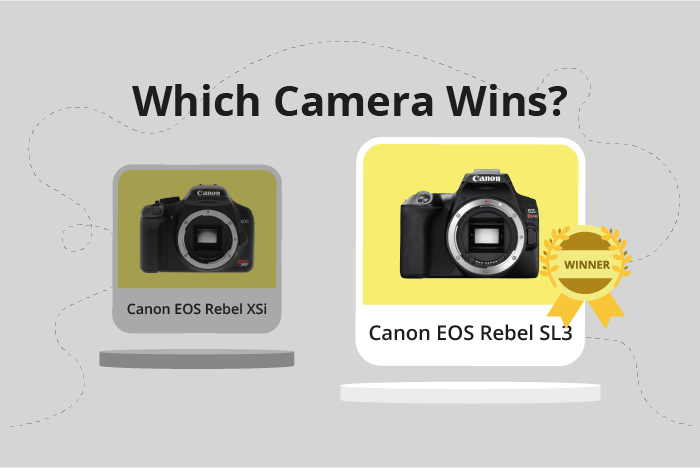Canon EOS Rebel XSi / 450D vs Rebel EOS SL3 / 250D Comparison
Canon EOS Rebel XSi / 450D

Canon EOS Rebel SL3 / 250D

The Canon Rebel EOS SL3 / 250D emerges as the winner with a score of 63/100, while the Canon EOS Rebel XSi / 450D scores 39/100. Both cameras are DSLRs, released in 2019 and 2008, respectively. They share similarities in specifications, such as camera type and launch prices (SL3: $599, XSi: $570).
The SL3 excels with its smaller and lighter design, measuring 122 x 93 x 70mm and weighing 449g, compared to the XSi’s 129 x 98 x 62mm and 524g. This makes the SL3 more portable and convenient for photographers on the go.
On the other hand, the XSi has a slightly slimmer depth, which could be a preference for some users. However, this advantage is minimal and does not significantly impact the overall performance of the camera.
Taking all factors into account, the Canon Rebel EOS SL3 / 250D is the superior choice due to its higher score, compact design, and lighter weight.
Canon EOS Rebel XSi / 450D vs Rebel EOS SL3 / 250D Overview and Optics
The Canon Rebel EOS SL3 / 250D comes out ahead in optics with a score of 61/100, compared to the Canon EOS Rebel XSi / 450D, which scores 42/100. Both cameras share several specifications, including the CMOS sensor type, APS-C sensor size, and compatibility with Canon EF/EF-S lenses.
The SL3 / 250D has several advantages over the XSi / 450D. Its higher megapixel count of 24 provides better image quality and resolution. The improved shooting speed of 5 frames per second allows for faster capture of action shots. The Digic 8 processor offers better performance and image processing capabilities. A higher DXOMARK score of 64 for the sensor indicates better overall image quality. Additionally, the SL3 / 250D features image stabilization, which aids in reducing blur caused by camera shake.
The XSi / 450D has fewer advantages in the optics department. Its lower megapixel count of 12.2 and slower shooting speed of 3.5 frames per second limit its performance in comparison to the SL3 / 250D. The older Digic III processor also falls short in comparison to the more advanced Digic 8. The XSi / 450D’s DXOMARK score of 61 is slightly lower than the SL3 / 250D’s, indicating a small difference in image quality.
Taking into account the shared specifications and the advantages of each camera, it is clear that the Canon Rebel EOS SL3 / 250D is superior in optics. Its higher score, better performance, and additional features, such as image stabilization, make it a better choice for photographers seeking improved image quality and capabilities.
Canon EOS Rebel XSi / 450D vs Rebel EOS SL3 / 250D Video Performance
When comparing the video capabilities of the Canon EOS Rebel XSi / 450D and the Canon Rebel EOS SL3 / 250D, it becomes clear that the XSi / 450D does not have video functionality. This is an important factor to consider for those who need a camera with video recording options.
On the other hand, the Canon Rebel EOS SL3 / 250D has a video score of 83/100, which indicates its strong performance in this area. The camera offers a maximum video resolution of 4K, with dimensions of 3840 x 2160. This high resolution ensures sharp and detailed video footage, suitable for a variety of uses.
Additionally, the SL3 / 250D can record at a maximum video frame rate of 60fps, which allows for smooth playback and the ability to capture fast-moving subjects with clarity. This camera also includes a built-in time-lapse functionality, providing users with the option to create stunning time-lapse videos with ease.
Taking these factors into account, it is evident that the Canon Rebel EOS SL3 / 250D is the superior choice for those requiring video capabilities in their camera. While the Canon EOS Rebel XSi / 450D may be suitable for photography alone, the SL3 / 250D provides users with a versatile camera that excels in both photo and video performance.
Canon EOS Rebel XSi / 450D vs Rebel EOS SL3 / 250D Features and Benefits
The Canon Rebel EOS SL3 / 250D outperforms the Canon EOS Rebel XSi / 450D with a feature score of 70/100, while the latter scores only 36/100. Both cameras share a screen size of 3 inches and lack GPS. However, the similarities end here, as the SL3 / 250D excels in other areas.
The Canon Rebel EOS SL3 / 250D boasts a screen resolution of 1,040,000 dots, compared to the XSi / 450D’s 230,000 dots. This higher resolution provides a clearer and sharper image preview. The SL3 / 250D also features a touchscreen, making it easier for users to navigate menus and adjust settings. Its flip screen allows for more versatile shooting angles, particularly useful for vlogging and self-portraits.
Connectivity is another area where the SL3 / 250D shines. It comes equipped with both WIFI and Bluetooth capabilities, enabling seamless transfer of images and remote camera control. The XSi / 450D lacks these features, making it less convenient for modern users.
Despite these disadvantages, the Canon EOS Rebel XSi / 450D may still appeal to users who prefer a simpler camera without advanced features. For those who do not require a touchscreen, flip screen, or connectivity options, the XSi / 450D could be a suitable choice.
Taking all factors into account, the Canon Rebel EOS SL3 / 250D is the clear winner in terms of features. Its higher screen resolution, touchscreen, flip screen, and connectivity options make it a more versatile and user-friendly option. However, the Canon EOS Rebel XSi / 450D may still find a niche among users who prefer a more basic camera.
Canon EOS Rebel XSi / 450D vs Rebel EOS SL3 / 250D Storage and Battery
The Canon Rebel EOS SL3 / 250D outperforms the Canon EOS Rebel XSi / 450D in storage and battery, with a score of 45/100 compared to the latter’s 27/100. Both cameras share similarities, such as having one memory card slot and accepting SD, SDHC, and SDXC memory cards. They also lack USB charging capabilities.
The SL3 / 250D surpasses the XSi / 450D in battery life and memory card compatibility. Its battery life reaches 1070 shots, while the XSi / 450D only manages 500 shots. Additionally, the SL3 / 250D is compatible with UHS-I memory cards, providing faster transfer speeds.
The XSi / 450D does not have any advantages in storage and battery over the SL3 / 250D. Its lower score in this category reflects its weaker performance.
Considering these points, the Canon Rebel EOS SL3 / 250D is the superior choice for storage and battery capabilities, offering longer battery life and better memory card compatibility. The Canon EOS Rebel XSi / 450D falls short in these aspects, making it less appealing for photographers who prioritize these features.
Canon EOS Rebel XSi / 450D vs Rebel EOS SL3 / 250D – Our Verdict
Are you still undecided about which camera is right for you? Have a look at these popular comparisons that feature the Canon EOS Rebel XSi / 450D or the Canon Rebel EOS SL3 / 250D:

